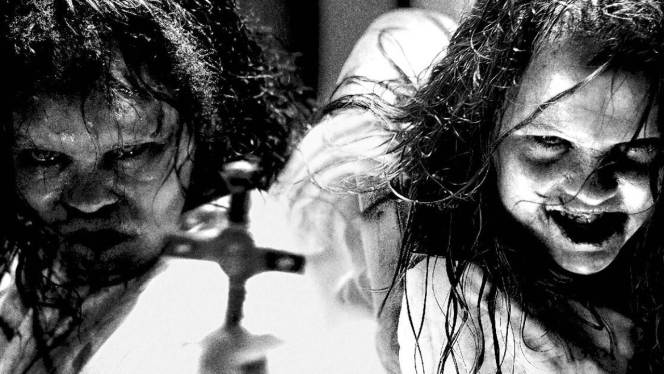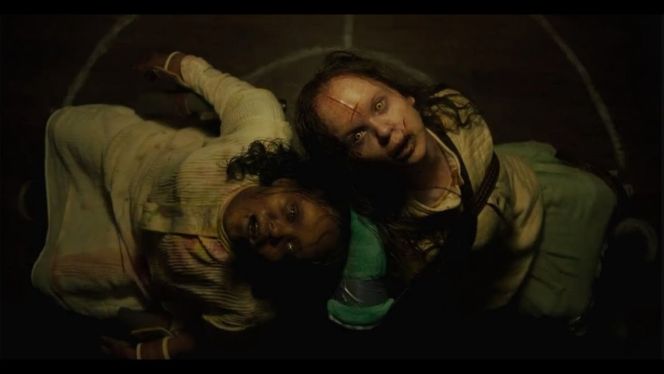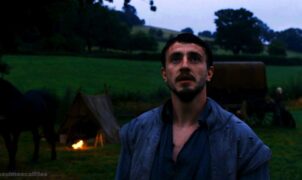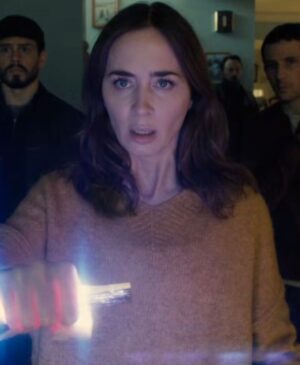PREVIEW – It has been exactly 50 years since one of the scariest horror films in film history hit the cinema screens, shocking audiences around the world. Now a new chapter begins. Blumhouse and director David Gordon Green, who resurrected the Halloween series, created The Exorcist: Believer.
Ever since his pregnant wife died in an earthquake in Haiti 12 years ago, Victor Fielding (Tony Award winner and Oscar nominee Leslie Odom, Jr.; One Night in Miami, Hamilton) has been raising his daughter Angela (Lidya Jewett, Sneaky Girls) alone.
When Angela and her friend Katherine disappear into the woods and emerge three days later with no memory of what happened to them, it sets off a chain of events that forces Victor to confront evil. In terror and despair, she seeks out the only person who has witnessed anything like this before: Chris MacNeil.
Oscar winner Ellen Burstyn returns as Chris MacNeil for the first time since the 1973 film. She is the actress whose life was changed forever by what happened to her daughter Regan five decades earlier. And now he tries to help the parents, when half a century later evil rears its head again…
The rich history of the film
After William Peter Blatty’s novel The Exorcist hit bookstores in 1971, the reading public threw themselves into the harrowing tale of shaken faith, family trauma, and demonic possession. William Friedkin’s film, based on the writer’s screenplay, was released in December 1973, and viewers were shocked by a previously unimaginable fear. The exorcist set revenue records, and its catchy, simple music haunted the viewers’ nightmares for a long time. Starring Ellen Burstyn, Max von Sydow and newcomer Linda Blair, the film proved to be a landmark in horror history, changing the genre and moviegoing habits forever.
Now, almost half a century later, The Exorcist: Believer heralds the dawn of a new era as audiences are confronted with unprecedented depths of evil. “The original The Exorcist marked a new era, and we pay tribute to it with this sequel,” says producer Jason Blum. – Fifty years have passed, thousands of horror films have been made since then, and we felt that we had to draw from the basics in order to come up with a disturbing and original story. We tried to convey the horror that a parent feels when the one who is most important to him in the world is in danger: his child. We also tried to analyze how one’s faith can develop when it becomes a guide, showing the way in a confused world.”
The heads of the production company Morgan Creek, James G. Robinson and David Robinson, bought the rights to The Exorcist from Blatty some 25 years ago, and since then they have been waiting for the perfect time and the perfect team to create another film. After seeing how successful Blum and writer-director David Gordon Green had been with the Halloween films, they approached Blum about opening a new chapter in The Exorcist’s story.
Green first developed the story with Scott Teems and Danny McBride, and then wrote the screenplay with Peter Sattler. The story centers on photographer Victor Fielding, who mourns the loss of his wife in the earthquake in Haiti. They try to move on with their daughter, Angela, but then a demonic creature enters the family, possessing the little girl and her best friend.
The terrible turn forces the lonely Victor to ask others for help, which is how he reaches Chris MacNeil, who is famous for having already completed an exorcism.
“One of the central themes of the film is: how can I overcome difficulties with the power of community? says Green. – Through the problem of demonic possession, we have the opportunity to examine much more tangible spiritual torments: the internal struggles that oppress us all. It’s a subgenre of horror that I’m extremely interested in because it raises questions like ‘Who am I?’, ‘Who lives inside me?’ yes, can the community free me from this with its love and care?’ I find these questions extremely exciting.”
As with the Halloween franchise, The Exorcist: Believer only considers the original 1973 film as canon, despite sequels over the decades. “As was seen with Halloween 2018, there’s a strong chance that the new generation doesn’t know the original The Exorcist,” explains Blum. – The Exorcist: Believer is a modern story that serves the vision of our time: a father raising his teenage daughter alone turns to his community for help in a trouble he never imagined. The story brings together the heroes and elements of the original work that horror fans love so much.”
In the film, Green was also able to dissect the topic that has long occupied him. “I have been interested in different religions since I was a child. If I see a film with a religious theme, I often read it.”
Although the 1973 film was based on a Catholic interpretation of possession, The Exorcist: Believer examines this issue from the perspective of multiple faiths. “The new story gave us the opportunity to look at obsession from different perspectives and interpret it from the perspective of each character’s religion,” says Green. “We present spectacular things, but we always look for the emotional roots and research how these extraordinary events can be explained and understood.”
The film is gripping, dramatic, dark and terrifying, concludes Blum. Making it was a real emotional rollercoaster for Green. “We had to find the joy in the darkness, the community in the loneliness, and show the human factor when the inhumanity is unleashed – I hope the audience will appreciate all of that.”
Spirituality and demonology
“The rite of exorcism is one of the most ancient rites of mankind. In all cultures, already at the dawn of writing, there were records of rituals that banished negative energies and showed the way to healing. Ancient Muslim, Jewish and Persian texts prove this, and several exorcism spells survive on the Dead Sea Scrolls.”
Chris MacNeil (The Exorcist: The Believer)
The 1973 film mainly dealt with the subject of exorcism in a Catholic approach, but in the current story several faiths are represented. “I tried to have a dialogue about the unknown in our film,” says Green. – Among other things, the film shows how bewildered a parent can be if their child is afflicted with an unspecified illness. How can we interpret such a crisis according to our own belief system, whether we are Baptists or atheists? What if a family believes in medicine or approaches it with suspicion? With these questions, our film joins the debate about the relationship between science and spirituality.”
Already in the early stages of the film’s development, Green strove to weave as many faith-related and non-faith-related threads into the story as possible. “When I was a child, we went to church on Sundays, but I was the kind of annoying kid who kept asking about faith because I was curious about what was behind the whole structure,” the director continues. – When I was young, I was influenced by different cultures, I met different religious approaches, I became close friends with people who believed in something completely different from what I was taught. So I approached the research with sincere curiosity, because I was seriously interested in what religious aspects could be used to approach obsession, and what rituals developed in this regard. I talked to scientists and religious leaders who recommended books on the subject.”
A good part of the research results was included in the film, and spiritual experts also helped the creators. Four religious leaders come together to save Angela and Katherine: a Catholic priest, Father Maddox (E.J. Bonilla), Victor’s friend Stuart, a Pentecostal preacher (Danny McCarthy), Doctor Beehibe, a Hudu shaman (Okwui Okpokwasili) and a Baptist preacher, Father Don Revans (Raphael Sbarge). (Hudu is a natural religion of African origin – not to be confused with the related voodoo – its tradition is still alive today in some southern states of the USA. According to the ancient belief, Hudu shamans have a close relationship with the supernatural – essentially they are naturopaths who use herbs and readings Hudu shamanism is the central motif of the satanic horror Angel Heart and the comic book adaptation Constantine – The Demon Hunter.
Carla Duren was the spiritual coordinator of the production, she took care of the spiritual and emotional balance of the actors and crew members. He emphasizes that most of the exorcism ceremonies and readings that can be seen and heard in the film are original, for example, Dr. Beehibe’s actions are rooted in African tradition.
Exorcism is still shrouded in mystery in the bosom of the Catholic Church. For example, according to Father Joseph Morris of the Archdiocese of Atlanta, no one in the Diocese of Atlanta knows who the official exorcist is. For the safety of the exorcist and the faithful entrusted to his care, it is a basic requirement that their identity not be revealed.
Professor Dr. David Bell researches the psychology of religion at the University of Georgia and was an expert during the making of the film. He believes that in America, the wealthier part of the population believes less in the existence of demons and angels than the poorer ones. Black churches are historically more connected to the supernatural, as are Pentecostal communities in rural regions.
The evil creature that haunts the little girls in the film is a blood-sucking female demon named Lamastu from the Mesopotamian religious world, who spreads diseases and kidnaps babies. About a thousand years before our era, Lamastu was depicted as a demon with the head of a lion, the body of a woman, and the feet of a bird. (The novel and the 1973 film featured another demon, Pazuzu.) The film’s Lamastu took half a year to create, with the carefully designed costume and terrifying mask tailored to Lize Johnston, who has extensive experience in bringing various horrors to life (Guillermo del Toro : Library of Horrors).
Even before the start of filming, Olivia O’Neill was taken to church by her mother to ask for a blessing (surely, on a sure basis). They ran into Martin Sheen, who gave the little girl his rosary to protect her during filming.
Source: UIP















Leave a Reply